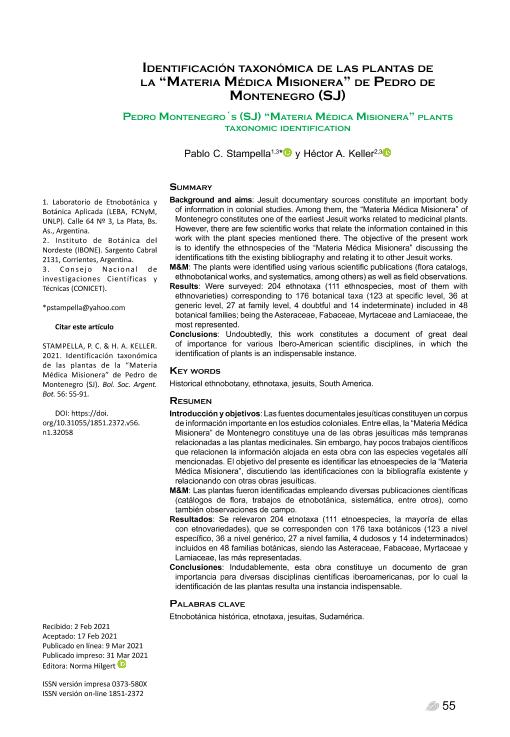Artículo
Introducción y objetivos: Las fuentes documentales jesuíticas constituyen un corpus de información importante en los estudios coloniales. Entre ellas, la “Materia Médica Misionera” de Montenegro constituye una de las obras jesuíticas más tempranas relacionadas a las plantas medicinales. Sin embargo, hay pocos trabajos científicos que relacionen la información alojada en esta obra con las especies vegetales allí mencionadas. El objetivo del presente es identificar las etnoespecies de la “Materia Médica Misionera”, discutiendo las identificaciones con la bibliografía existente y relacionando con otras obras jesuíticas. M&M: Las plantas fueron identificadas empleando diversas publicaciones científicas (catálogos de flora, trabajos de etnobotánica, sistemática, entre otros), como también observaciones de campo. Resultados: Se relevaron 204 etnotaxa (111 etnoespecies, la mayoría de ellas con etnovariedades), que se corresponden con 176 taxa botánicos (123 a nivel específico, 36 a nivel genérico, 27 a nivel familia, 4 dudosos y 14 indeterminados) incluidos en 48 familias botánicas, siendo las Asteraceae, Fabaceae, Myrtaceae y Lamiaceae, las más representadas. Conclusiones: Indudablemente, esta obra constituye un documento de gran importancia para diversas disciplinas científicas iberoamericanas, por lo cual la identificación de las plantas resulta una instancia indispensable. Background and aims: Jesuit documentary sources constitute an important body of information in colonial studies. Among them, the “Materia Médica Misionera” of Montenegro constitutes one of the earliest Jesuit works related to medicinal plants. However, there are few scientific works that relate the information contained in this work with the plant species mentioned there. The objective of the present work is to identify the ethnospecies of the “Materia Médica Misionera” discussing the identifications tith the existing bibliography and relating it to other Jesuit works. M&M: The plants were identified using various scientific publications (flora catalogs, ethnobotanical works, and systematics, among others) as well as field observations. Results: Were surveyed: 204 ethnotaxa (111 ethnospecies, most of them with ethnovarieties) corresponding to 176 botanical taxa (123 at specific level, 36 at generic level, 27 at family level, 4 doubtful and 14 indeterminate) included in 48 botanical families; being the Asteraceae, Fabaceae, Myrtaceae and Lamiaceae, the most represented. Conclusions: Undoubtedly, this work constitutes a document of great deal of importance for various Ibero-American scientific disciplines, in which the identification of plants is an indispensable instance.
Identificación Taxonómica de las Plantas de la ''materia Médica misionera'' de pedro de Montenegro (SJ)
Título:
Pedro montenegro'S (SJ) ''materia Médica Misionera'' Plants Taxonomic Identification
Fecha de publicación:
03/2021
Editorial:
Sociedad Argentina de Botánica
Revista:
Boletín de la Sociedad Argentina de Botánica
ISSN:
0373-580X
e-ISSN:
1851-2372
Idioma:
Español
Tipo de recurso:
Artículo publicado
Clasificación temática:
Resumen
Palabras clave:
ETHNOTAXA
,
ETNOBOTÁNICA HISTÓRICA
,
JESUITAS
,
SUDAMÉRICA
Archivos asociados
Licencia
Identificadores
Colecciones
Articulos(CCT - LA PLATA)
Articulos de CTRO.CIENTIFICO TECNOL.CONICET - LA PLATA
Articulos de CTRO.CIENTIFICO TECNOL.CONICET - LA PLATA
Articulos(IBONE)
Articulos de INST.DE BOTANICA DEL NORDESTE (I)
Articulos de INST.DE BOTANICA DEL NORDESTE (I)
Citación
Stampella, Pablo César; Keller, Hector Alejandro; Identificación Taxonómica de las Plantas de la ''materia Médica misionera'' de pedro de Montenegro (SJ); Sociedad Argentina de Botánica; Boletín de la Sociedad Argentina de Botánica; 56; 1; 3-2021; 55-91
Compartir
Altmétricas




